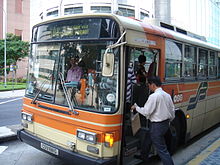- City Shuttle Service
-
Singapore Shuttle Bus Private Limited was a subsidiary of SMRT Corporation in Singapore that operated bus services under the name of City Shuttle Service (CSS) between 15 May 1975 and 28 April 2007.
Contents
History
The City Shuttle Service (CSS) was an initiative introduced in 15 May 1975 by the Singapore Government, which was intended to be part of a Park and Ride scheme aimed at reducing traffic congestion in the city. It was originally hoped that car owners would park at designated car parks and transfer to CSS bus services to enter the Central Business District (CBD). 11 inaugural services commenced operations by NTUC Comfort & Singapore Shuttle Bus (SSB), which plys along the 16 fringe car parks, 7 city area terminus and 49 selected bus stops with around sixty 25-seater single door buses. However, the initial arrangement was not popular with car owners and the scheme was terminated, resulting in the company being allowed to operate regular services to the CBD from HDB housing estates like Bukit Merah, Bedok, St Michael's Estate, Marine Parade, Holland Road & Sin Ming Rd and had reduced to 9 services (6 services were from SSB and the 3 were from NTUC Comfort). As the purpose of the CSS scheme was to service working commuters, no services were operated on Sundays and public holidays.[1]
On 25 June 1988, NTUC Comfort, which ran the 3 CSS services from Marine Parade to the city, decided to withdraw 2 services partly due to the high maintenance cost of its buses and a decline in commuter demand due to the MRT's opening. Its buses then ran on its last sole service until 1990, when the buses reached the end of their permitted lifespan.
The initial fleet was replaced with larger DAF SB220 and Nissan Diesel buses. CSS was the first bus operator in Singapore to introduce senior concessionary fares, a scheme that was eventually extended to other bus operators. On 12 March 1987, Singapore Shuttle Bus was purchased by Trans-Island Bus Services (TIBS). When TIBS was in turn purchased by SMRT Corporation in 2001, the company came under the control of SMRT. At the point of the merger, the company was operating five routes and its depot was based at Lorong 1 Geylang Bus Terminal.[1]
Demise
Greatly improved public transport connections resulted in a fall in ridership numbers at the turn of the millennium. With the withdrawal of CSS Service 605 on 5 September 2004, its existing fleet of CSS buses were being downsized, with the DAF SB 220LT buses awaiting to be exported overseas and was later used in New Zealand, leaving the Nissan buses in its fleet. With the gradual decrease in ridership, some of the Nissan buses with CSS plates were transferred to the SMRT fleet in June 2006. SMRT progressively withdrew CSS routes, ending with the last route, Service 608, on 28 April 2007. The parent company justified this action on the grounds of reduced ridership of up to 40% and lower fares which made it impractical for the CSS scheme to continue.[2]
With the withdrawal of the route, Singapore Shuttle Bus was liquidated. The remaining of the CSS Nissan buses were transferred to SMRT Buses (Dennis Lance,Nissan Diesel) for continued operations, 2 months after its withdrawal of Service 608.
References
- ^ a b History of Singapore Shuttle Bus, SMRT Buses, retrieved 10 November 2007
- ^ "Last City Shuttle bus service ends next month", The Straits Times, 21 March 2007
See also
Categories:- Bus companies of Singapore
- Defunct companies of Singapore
Wikimedia Foundation. 2010.

